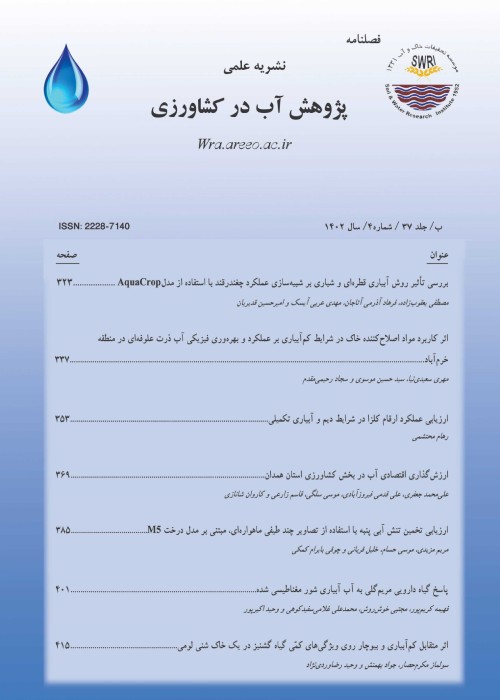Effect of Irrigation Water Salinity on Relative Yield and Some Morphological and Physiological Characteristics of Sorghum
Salinity is one of the most important abiotic stresses that has many negative effects on plant growth. To investigate the effect of salinity water irrigation stress on morphological and physiological characteristics of sorghum, an experiment was conducted in a randomized complete block design with 3 replications in soil columns located in the Agricultural and Natural Resources Research Center of Mazandaran Province. The number of experimental columns was 15 and the duration of the experiment was 56 days. Salinity treatments included well water (control) (S1=0.995 dSm-1), Mix seawater and well water in proportions 1/4 (S2=4.680 dSm-1), 2/4 (S3=8.130 dSm-1), 3/4 (S4=13.710 dSm-1) and seawater (S5=15.910 dSm-1). In this study, dry and wet weight of shoots, seeds and roots, diameter and height of main stem, leaf area index, leaf area, harvest index, biological yield and resistance indices of sorghum were measured. The results of analysis of variance showed that the effect of salinity on all measured traits was significant. Increasing the salinity level of irrigation water from control (S1) to treatment (S5) caused a significant decrease at the rate of 1 to 70% in all measured traits except harvest index and root to stem ratio. Also the results of this study showed that the best salinity level to achieve maximum yield in sorghum (Equivalent to 13/218 g) is salinity level (S1). Regarding resistance indices, S1 treatment had higher k/Na and Ca/Na ratios than other treatments, which were 6.67 and 1.4, respectively. Also, the results of comparing the mean of traits between different treatments showed that there were no significant differences between S3 and S4 treatments in traits such as grain yield, straw yield, plant height, leaf area, harvest index, dry weight of root and resistance indices that Up to 3: 1 ratio, seawater to well water can be used to grow sorghum. Also, the relative yield of sorghum to salinity did not decrease by about 3.65 dS /m, which was considered as the tolerance threshold of this plant. But after increasing the salinity of soil saturated extract, plant yield decreased and at salinity of about 15 dS /m was halved. The slope of the sorghum yield reduction line at this stage was calculated to be 3% dS / m.
- حق عضویت دریافتی صرف حمایت از نشریات عضو و نگهداری، تکمیل و توسعه مگیران میشود.
- پرداخت حق اشتراک و دانلود مقالات اجازه بازنشر آن در سایر رسانههای چاپی و دیجیتال را به کاربر نمیدهد.



